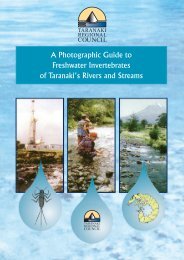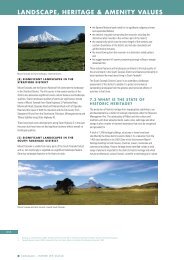safety data sheet
safety data sheet
safety data sheet
You also want an ePaper? Increase the reach of your titles
YUMPU automatically turns print PDFs into web optimized ePapers that Google loves.
addition fine droplets are blown away from the spray area. Thus in these conditions spraying is not<br />
recommended.<br />
Dispersant application options<br />
Backpacks<br />
Backpacks are light, portable and cheap, but have a small payload and low application rate. They can<br />
be useful for application from small boats for limited treatment in difficult to access areas such as<br />
around wharf piles. It is easy to exceed recommended dose rates using backpack applicators.<br />
Vessel-based<br />
Vessel-based systems can be fitted to many types of vessel, but the oil encounter rate is quite low. As<br />
slicks are not of uniform thickness, boats need to be directed by spotter aircraft to areas of thicker oil.<br />
Fixed-wind aircraft<br />
Fixed-wing aircraft based systems allow a rapid response and a high treatment rate. Small aircraft<br />
(e.g. crop spraying aircraft) have a small payload but are useful for near-shore waters. However they<br />
require adaptation and this takes time. Spray nozzles used for crop spraying may not be suitable for<br />
dispersant spraying and therefore have to be changed if they are unable to deliver droplets of 400µm<br />
– 1000µm.<br />
Helicopter<br />
Helicopter-based systems can operate from a base near the spill, and can be used on small spills in<br />
confined or inaccessible situations. The spray nozzles used for crop spraying may not be suitable for<br />
dispersant spraying and therefore have to be changed if they are unable to deliver droplets of 400µm -<br />
1000µm.<br />
Application rates<br />
The ratio of dispersant to oil required for effective dispersal varies between 1:5 and 1:30. Depending<br />
upon the type of oil and prevailing conditions. As a general guide, a dispersant starting ratio (dose<br />
rate) of between 1:20 and 1:30 is recommended.<br />
In calculating application rates an allowance must be made for losses of dispersant spray during its<br />
passage through the air to the sea surface. It is essential to reduce to a minimum those losses due to<br />
wind drift and air turbulence. Large droplets assist in this respect but in addition the aircraft should be<br />
flown as low as <strong>safety</strong> considerations allow. Typically an altitude of 5 – 15m should be used.<br />
Dispersant should be applied as droplets with a mean diameter in the range 600 – 800 m.<br />
1. Determine thickness of oil:<br />
As a general rule, most liquid oils spread to an average thickness of 0.1mm.<br />
2. Determine volume of oil in one hectare:<br />
volume = oil thickness (m) x 10,000 m2<br />
(0.1mm thickness = 1m3 or 1000 litres)<br />
3. Determine application rate:<br />
Application rate (litres/hectare) = volume / dose ratio<br />
Typical starting ratios of dispersant to oil are between 1:20 and 1:30.<br />
(for a dose ratio of 1:20 the appropriate application rate would be 1000/20 = 50 litres/hectare<br />
0.005 litres/m2)<br />
4. Determine application speed or discharge rate (depending on known variables):<br />
discharge rate (litres/sec) = application rate (litres/m2) x swath (m) x speed (m/s)<br />
speed (m/s) = discharge rate (litres/sec)<br />
National Marine Oil Spill Contingency Plan Page 6 of 45<br />
Chapter 7 – Dispersants Use Issue 7 June 2012














